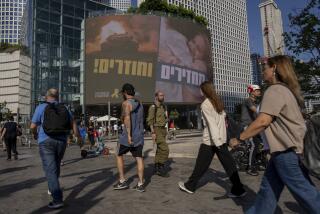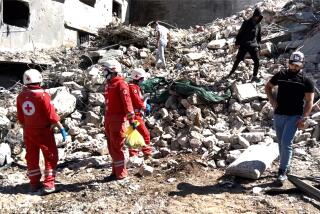Curfew lifted in Baghdad, but familiar fears linger
BAGHDAD — Stray bullets streaked through the sky. Mortar shells and rockets thundered into residential areas sapped of street life except for the few people willing to venture beyond their front gates.
A walk in his own backyard proved deadly for one man. He was hit by a wayward bullet in his neighborhood in Baghdad, where fighting between Shiite Muslim militias and Iraqi and U.S. forces has revealed how shaky Iraq’s security situation is.
An around-the-clock curfew was eased today, giving Baghdad’s 6 million people the freedom to move about for the first time in four days. Psychologically, though, the lockdown is likely to last far longer. Iraqis had embraced a relative calm in recent months, only to find themselves prisoners in their homes and offices.
For five years, U.S. and Iraqi officials have cautioned that progress takes time. Just as it seemed that progress on the security front, at least, was tangible, everything turned around again.
The capital’s normally traffic-choked streets were deserted. People risked being caught in crossfire, walking for hours to check on relatives or reach their jobs. Neighborhoods resembled ghost towns.
A Times staffer walked several miles Sunday to reach the funeral of his brother-in-law, who had been killed in crossfire. Mahdi Army militiamen loyal to Shiite cleric Muqtada Sadr had used bricks and the trunk of a palm tree to block the entrance to his destination, the southwestern neighborhood of Bayaa. They let the staffer pass after he explained that he was going to a funeral.
By Sunday night, kitchens were low on food. The few neighborhood markets open had quadrupled prices of the scarce goods available. Generators were running out of fuel. People who had been at work when the curfew was imposed Thursday night were missing their families. Patience was wearing thin.
About half a mile from Leith Abass’ home in Shula, a northwestern Baghdad neighborhood, masked gunmen loitered. Occasionally, they traded fire with U.S. forces positioned on the overpass of a nearby highway.
Food came from a tiny shop across the street from his house, but every visit to the market was risky.
“There is shooting every now and then around us, and it starts and ends very rapidly,” Abass said in a phone interview. “You never know what could happen.”
There had been no electricity for four days, and his generator had run out of fuel, forcing Abass to buy some from his neighbor “just so I could listen to some news and cool the water in the refrigerator.”
To the south, in the area known as Ilam, Haydar Ammar’s anger was evident.
“The situation is unbearable,” Ammar said as his baby screamed in the background. But he added sarcastically, “Frankly speaking, we got used to this kind of living during the past several decades,” a reference to the hardships under Saddam Hussein’s dictatorship and since the U.S.-led invasion in March 2003.
He told of his neighbor, Sawki Raad, who had gone into his yard Saturday night to flip the switch on his circuit breaker after his power went out.
A stray bullet hit Raad and killed him. No one knew who fired it or why. Nobody was willing to try to find out.
“I haven’t gone out of the house during these past few days,” Ammar said. “I could hear shooting and explosions every now and then. I don’t really know where it’s coming from. I’m not going to risk my life to find out.”
Unlike the violence that enveloped Baghdad after the February 2006 bombing of a revered Shiite mosque that pitted Shiites against Sunnis, the latest violence has affected predominantly Shiite areas. That has left mainly Sunni areas far more relaxed.
Children in Qadisiya, a predominantly Sunni district in southwest Baghdad, played soccer in the streets while young men washed their cars and older people tended their gardens. Unlike residents of Shiite neighborhoods, they did not have to worry about mortar strikes or gun battles breaking out nearby.
“We are happy. We’ve been playing soccer from the morning till evening,” said 13-year-old Ahmed Rawi as he kicked a ball with friends. “There is no school, and we don’t have homework or exams.”
Iraqi security checkpoints were erected at the main roads leading into Qadisiya, but pedestrians were allowed to pass unhindered.
Some U.S. military officials say that one result of the recent fighting has been a growing disenchantment among Shiites with the militias involved in the unrest. Scattered incidents seemed to bear that out.
In Shaab, a Shiite neighborhood near the Baghdad slum of Sadr City, gunmen from the Mahdi Army ducked into an elderly woman’s house while being chased by U.S. forces. She screamed at the militiamen to get out, a resident said.
In the same neighborhood, a U.S. helicopter fired a missile at a group of militiamen preparing to launch a mortar on a residential street. The airstrike killed some of the men but also damaged a nearby house and injured a little girl inside.
“Why are you trying to show your bravery here among civilians?” her father yelled as he tore out of his house and ran toward the surviving militiamen. He challenged them to take their fight with U.S. forces elsewhere, such as to an American military post nearby, “and fight them face to face!”
The next morning, pools of blood remained in the street where the missile had struck.
On Sunday evening, loudspeakers blared the news across Sadr City that the Shiite cleric had called for an end to fighting. Some people handed out candy as a symbol of celebration, anticipating that Baghdad residents would once again be free to do their shopping, go to work, and bury their dead.
--
Times staff writers Alexandra Zavis, Said Rifai, Saad Khalaf and Saif Rasheed and special correspondents in Baghdad contributed to this report.
More to Read
Sign up for Essential California
The most important California stories and recommendations in your inbox every morning.
You may occasionally receive promotional content from the Los Angeles Times.











